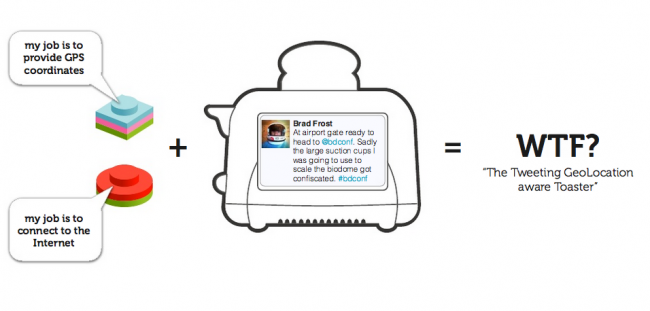BDConf: Stephanie Rieger presents Reset the Web
In Reset the Web, Stephanie Rieger (@stephanierieger) explains how mobile is just a glimpse into the very early stages of an entirely new digital ecosystem system.
- The web is less than 8,000 days old.
- What is the web actually for? Man as a tool maker has the ability to amplify our inherent ability. The computer amplifies memory, problem-solving, calculation, projection, analysis
- The Internet amplifies knowledge. The true potential of the Internet was revealed only when it became ubiquitously available.
- A smartphone is not a smartphone, it’s a device to simplify curiosity. It’s always connected to an open platform accessible by anyone with a browser
- “Hold on, Let me look that up. I just happen to have to sum of human knowledge in my pocket.” “The magic is in the palm of my hands”
- The internet is what brings these devices to life. Without connectivity, these devices could only perform a limited number of tasks.
- Technological revolutions require a level of plumbing. The web requires cables and connections, and so invention, implementation and market adoption influence what’s possible. It takes a long time to evolve the necessary plumbing to drive innovation.
- Internet “plumbing” is the scaffold on top of which we innovate.
- Emerging economies are skipping the traditional computing model (desktops, fixed lines and infrastructure) and are instead jumping straight to mobile infrastructure.
Contexts will be varied and unpredictable.
- Current products are still deeply rooted in the past, but new diverse platforms and interactions will emerge. Small, large, mobile, immobile, and everything in between.
- Contexts may be diverse, but they still ‘fit’ our mental model of the web
In the future, everything will be connected.
- Cotton Candy computer: plug a smart computer into any dumb computer Many unknown unknowns.
- Google’s Project Glass and other speech-and-voice interfaces show us how not every connected device will rely on a screen.
- Old “thing” + connectivity + software + UI = New smart “thing”
- It now costs next to nothing to make something smart or connected. Emerging chips don’t require a traditional power supply, meaning they can be embedded in anything.
“Just in time” will replace “Just in case”
- Right now, we have to go to the web , but in the future the web will come to us. In the future, things will tell us information rather than us having to seek out information about the thing.
- “We don’t want the app. We want what the app does. We could care less if we have the app, we just want the functionality.”
- In the future, our devices load applications opportunistically that are accessed seamlessly.
- No new technology fully replaces the old, it simply augments it.
- The most profound technologies are those that disappear. They weave themselves into the fabric of everyday life until they are indistinguishable
Content will need to flow like water.
- Responsive design is just the beginning. It’s not just about flexible layouts, it’s about flexible content
- The browser and web platform. It’s easy to forget how much infrastructure we’ve built into the web and browser. Things like forms serve an important purpose.
- Things we add are often a response to change. Interface conventions change as technology becomes available. “We have a robust browser now, how do we navigate it?” Reader apps are a response to clutter
- Proxy web browsers are giant polyfills. They add a lot of value as they bridge the gap between the capable and incapable.
- Tools that bridge the gap to respond to change: “Reader” apps, UA switching on mobile browsers
- The rise of more baked-in features, like HTML5 forms. They’re intelligent, responsive, platform-appropriate yet adaptable components. What if we applied this to other components?
- Everything you add to the page is something you’re taking away from the latency profile of the page. Everything you add should have real value.
- ‘Back to Top’ links are useful and easy to implement for long mobile pages. Why aren’t they baked this into all browsers?
- Social media widgets are currently implemented client-side. These should eventually be offloaded to the platform. They should be considered plumbing. Mobile is the needle, social is the thread. -Pew
- There are only so many ways to re-arrange complex navigation. Some sites are just complex, period. What about a native trigger that fires up a default browser “menu” component, similar to datepicker, or select menu, etc.
- Media formats aren’t adaptive enough. We keep forgetting about user choice. They are the best ones to determine what quality of media they want.
- Look to Quicktime wired media (used connection speed and screen size) as a reference. Drop in a self-contained package that allows you to not have to worry about the logic
- Cultural change more dramatic, but we tend to focus on the technologies themselves.
I’ve now had the opportunity to hear Stephanie present on multiple occasions, and every time I am completely blown away. This time, I was honored to make it into Stephanie’s slides in the form of a tweeting smart toaster. I’m very happy about that!

One Comment
Lawrence D'Oliveiro
“Back to top”? You’re kidding me!
Comments are closed for this post. If you've got something to add, feel free to reach out on Twitter.